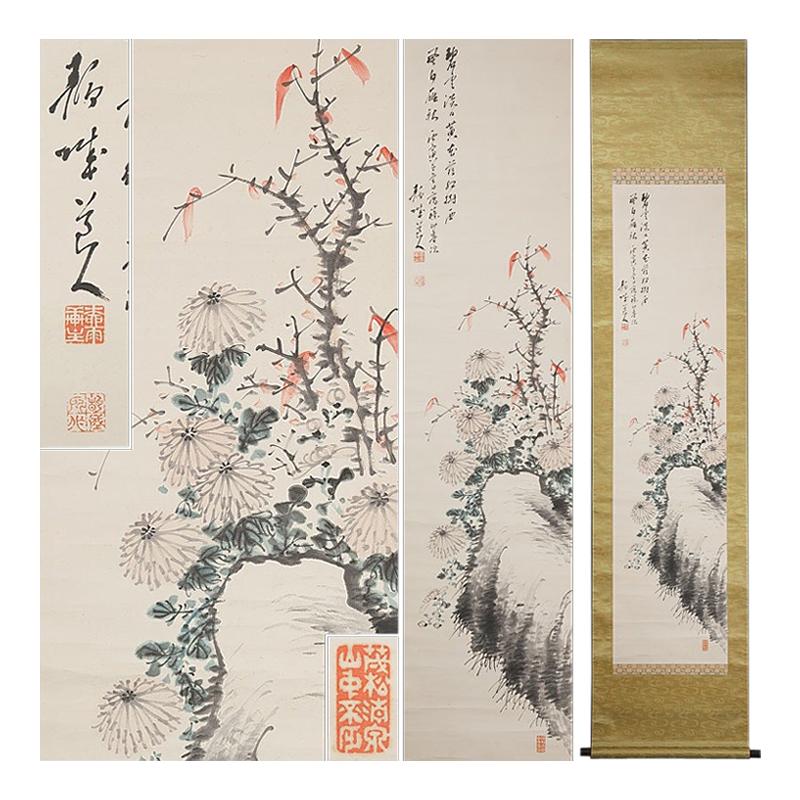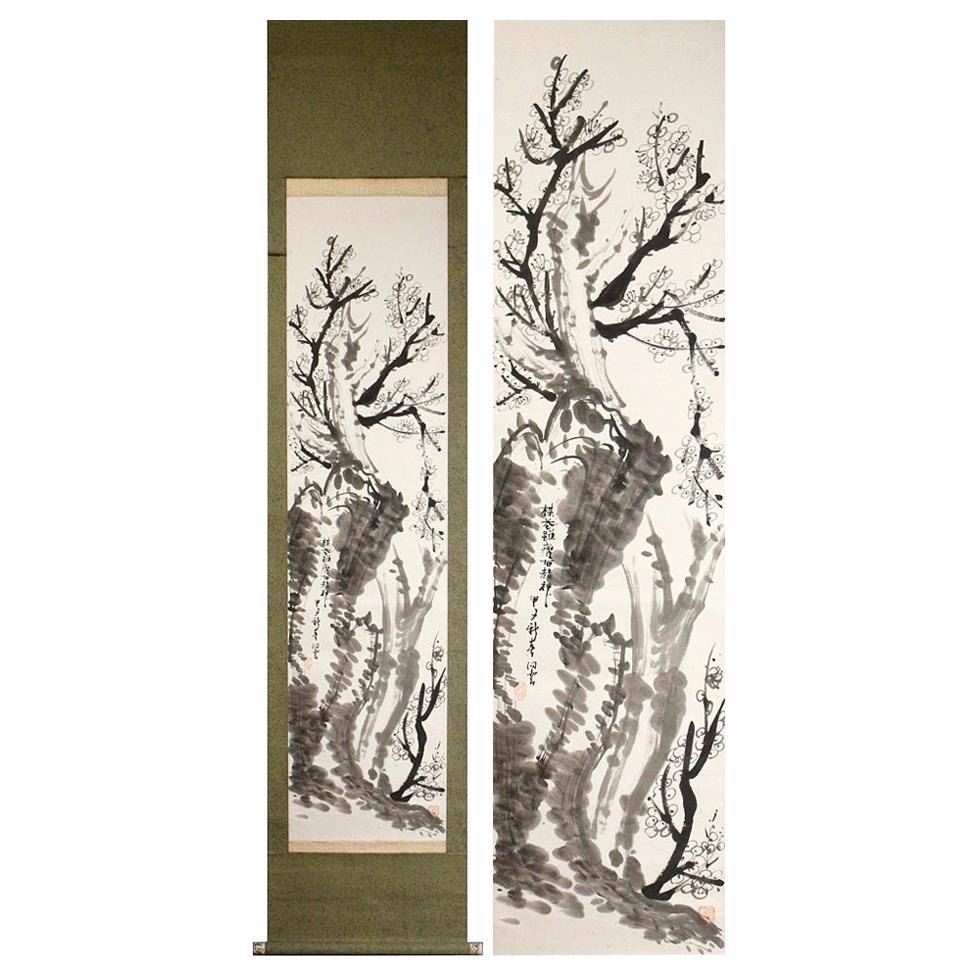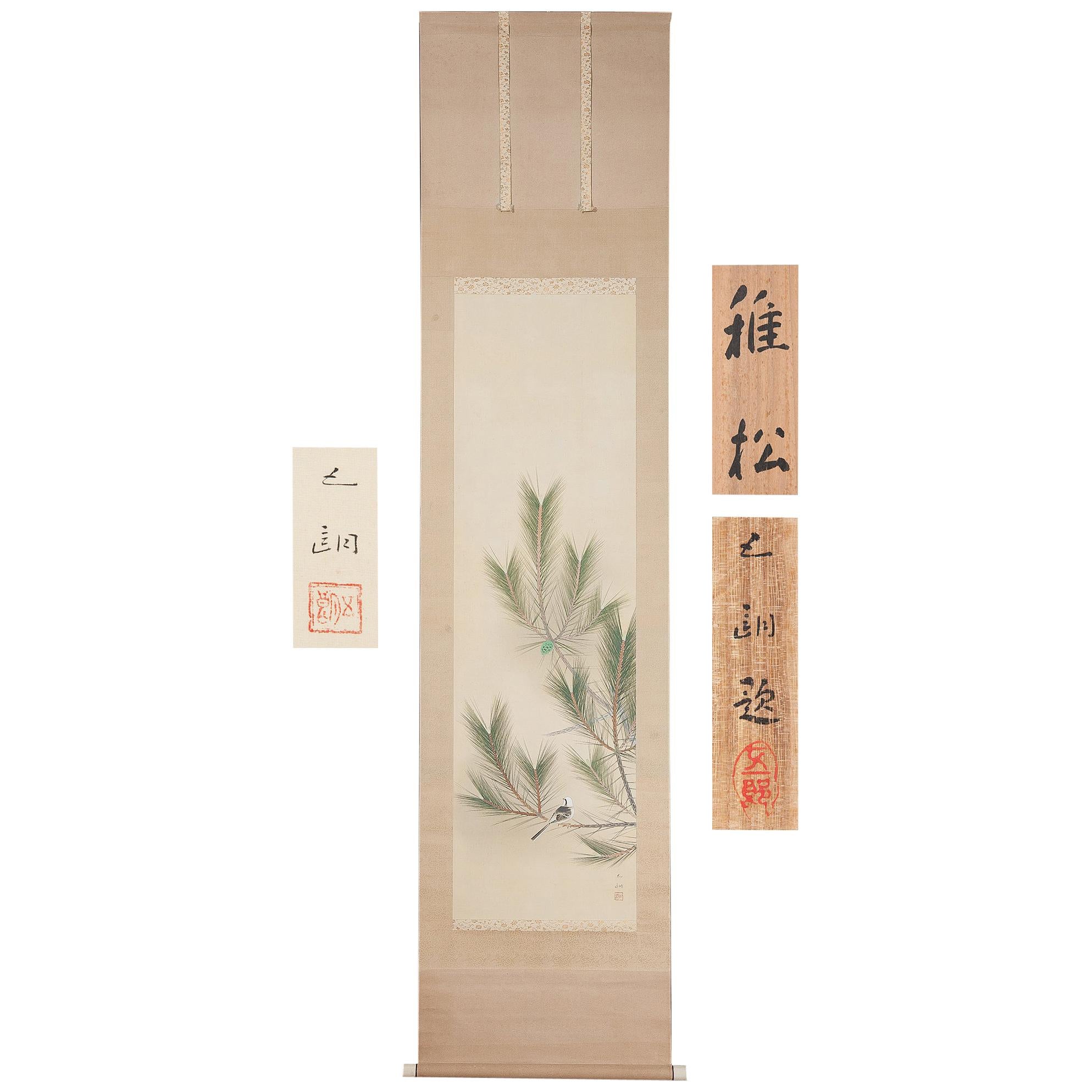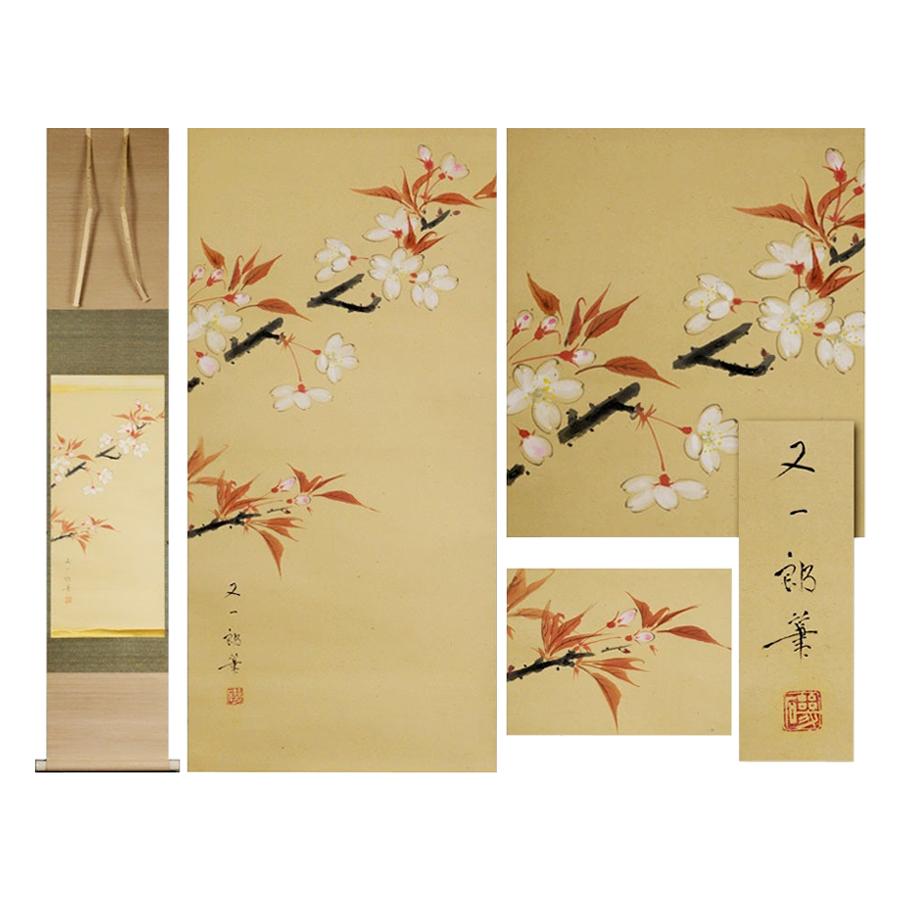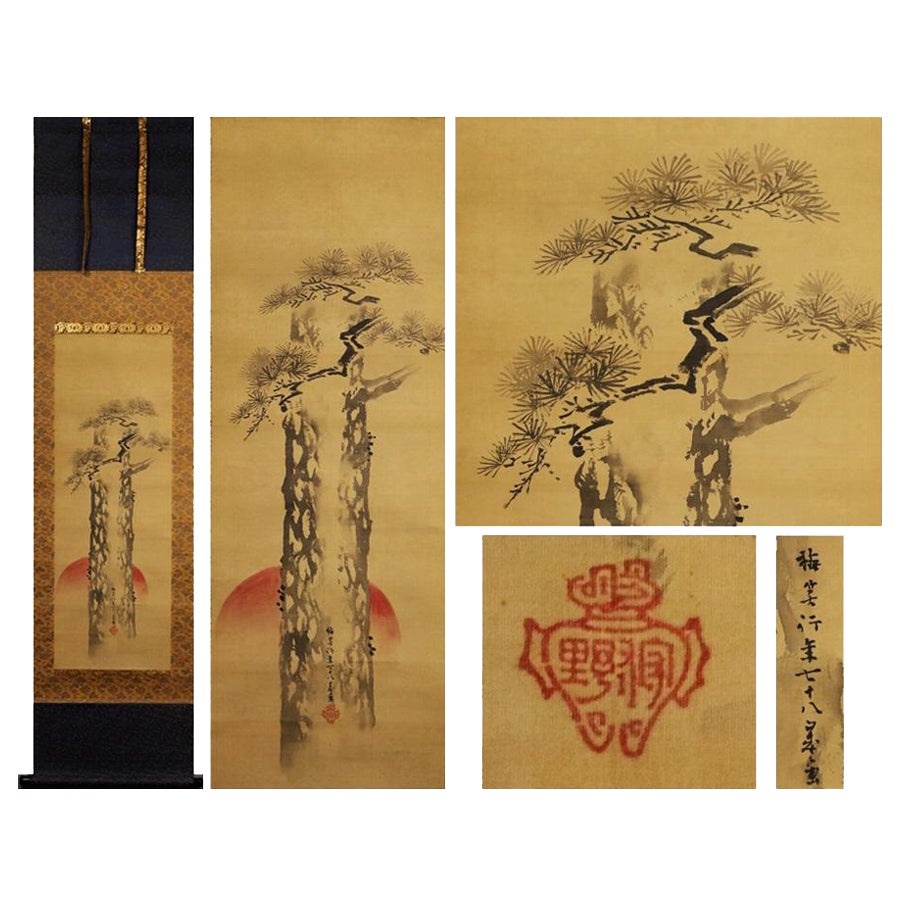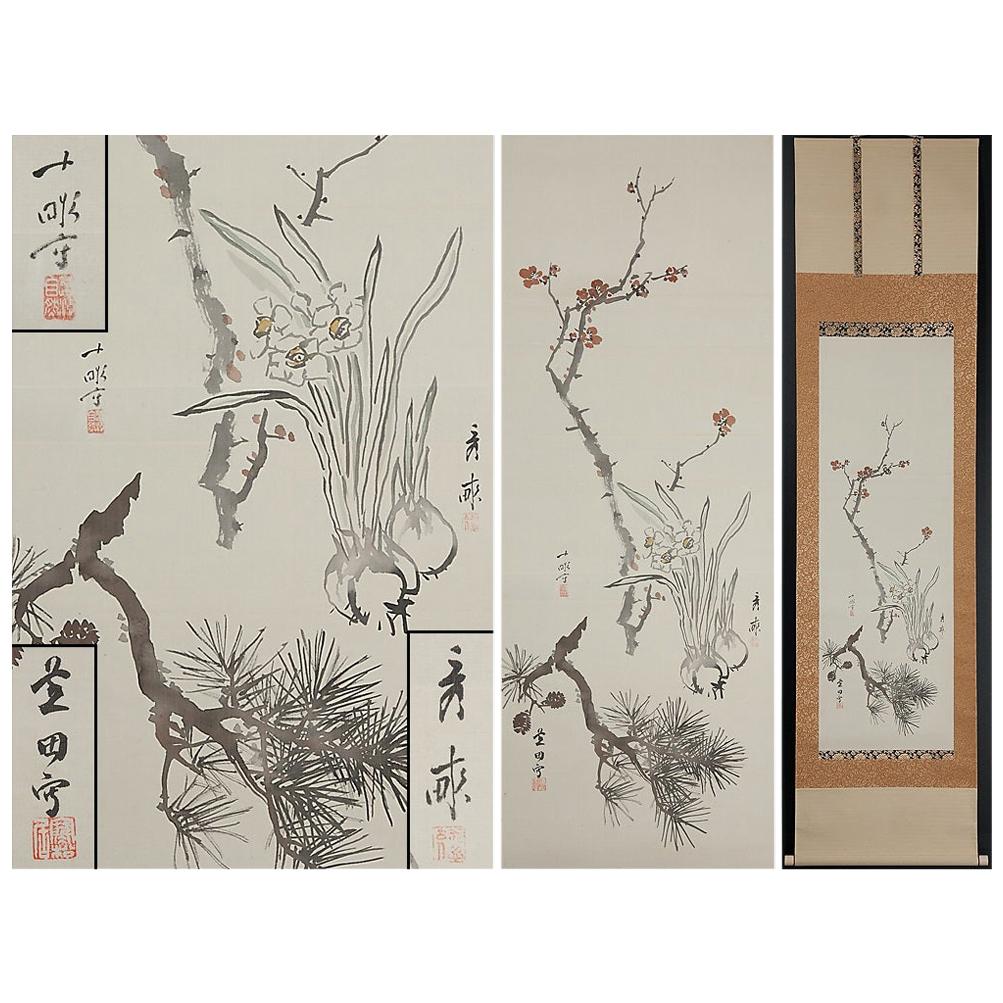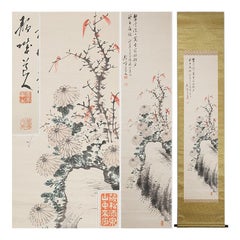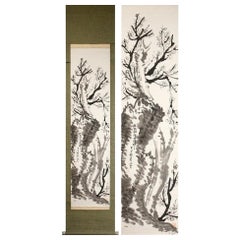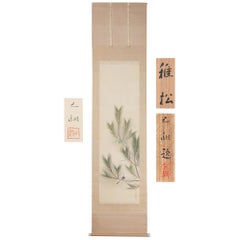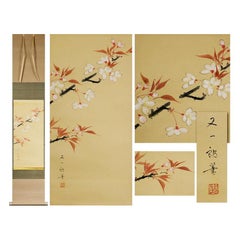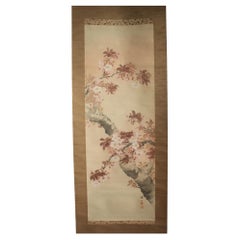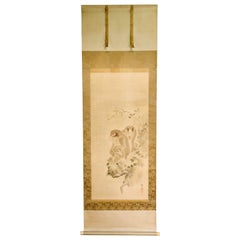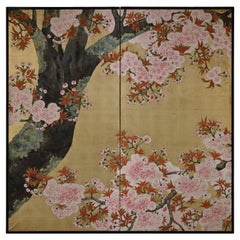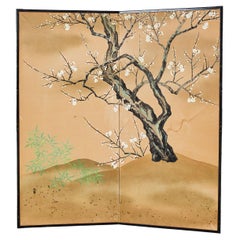Items Similar to Blossom and Tree Scene Meiji Period Scroll Japan 19c Artist Araki Kanpo
Want more images or videos?
Request additional images or videos from the seller
1 of 5
Blossom and Tree Scene Meiji Period Scroll Japan 19c Artist Araki Kanpo
$5,032.20
$6,290.2520% Off
£3,746.15
£4,682.6920% Off
€4,200
€5,25020% Off
CA$6,892.86
CA$8,616.0820% Off
A$7,666.37
A$9,582.9620% Off
CHF 4,003.14
CHF 5,003.9220% Off
MX$93,291.51
MX$116,614.3920% Off
NOK 51,126.18
NOK 63,907.7220% Off
SEK 47,947.33
SEK 59,934.1720% Off
DKK 31,973.13
DKK 39,966.4220% Off
Shipping
Retrieving quote...The 1stDibs Promise:
Authenticity Guarantee,
Money-Back Guarantee,
24-Hour Cancellation
About the Item
If it is good enough for the Japanese emperor :)
The painting's inscription says that it was painted in the artist's 82nd year, which would be 1913.
In the early Meiji Period following the Buncho ideal of hasshu kengaku ('learning eight schools'), Kanpo expanded his talents to incorporate Western painting techniques and began studying oil painting with Kawakami Togai (1827-1881) and Kunisawa Shinkuro (1847-1877). He achieved notable recognition as an oil painter and apparently was awarded the honor of painting a portrait of the Empress Dowager. Later Kanpo returned to Nihonga and continued to receive numerous honors for his work. He received a silver medal (2nd place) at the Tokyo Prefecture Crafts Competition in 1887; 2nd place with a painting of peacocks at the 3rd Domestic Industrial Exposition in 1890; and many other prizes at the Japan Art Association over the years. His paintings were also included in many international exhibitions; he won awards at the Chicago World's Fair in 1893; the Paris Exposition Universelle in 1900; and the St. Louis World's Fair in 1904. In 1898 when Hashimoto Gaho left the Tokyo School of Fine Arts (Tokyo Bijutsu Gakko) Kanpo became the professor of painting. In 1900 he was made Imperial Household Artist (Teishitsu gigeiin) and from 1907 he was a judge at the government sponsored exhibition Bunten.
«Araki Kanpo»
Born in 1831 (Tenpo 2nd year).
A painter and Japanese-style painter who was active from the end of the Edo period to the Meiji era in Japan.
His real surname is Tanaka. The childhood name is Kozaburo. Kanpo is the issue, and
other issues include Kumoi, Hashimura, Kiyoshi, the owner of the poetry hall, and Tatsuan.
He studied under Araki Kanpo and was adopted. He specializes in bird-and-flower painting, and became a painter of Toyonobu Yamauchi, the lord of the Tosa Kochi feudal lord in the 3rd year of Ansei. After the restoration, a temporary Western-style film was applied to Kawakami Togai and others. Professor of Tokyo University of the Arts (currently Tokyo University of the Arts) in 1891. Imperial artist.
He specializes in bird-and-flower painting with dense colors and detailed depictions.
He died in 1918. 85 years old.
¦ Silk book / handwriting.
¦ Condition
There are some stains.
¦ Shaft dimensions / approx. 208.0 cm x approx. 64.5 cm.
¦ Paper dimensions / approx. 127.0 cm x approx. 49.5 cm.
¦ Signs / There are inscriptions and seals as you can see.
¦ Box / double box.
- Dimensions:Height: 81.89 in (208 cm)Width: 25.4 in (64.5 cm)Depth: 0.04 in (1 mm)
- Style:Meiji (Of the Period)
- Materials and Techniques:
- Place of Origin:
- Period:
- Date of Manufacture:1913
- Condition:Wear consistent with age and use. ■ Condition There are some stains. ■ Shaft dimensions / approx. 208.0 cm x approx. 64.5 cm. ■ Paper dimensions / approx. 127.0 cm x approx. 49.5 cm. ■ Signs / There are inscriptions and seals as you can see. ■ Box / Double box.
- Seller Location:Amsterdam, NL
- Reference Number:Seller: 1330917030031stDibs: LU4863223228362
About the Seller
5.0
Platinum Seller
Premium sellers with a 4.7+ rating and 24-hour response times
Established in 2015
1stDibs seller since 2019
264 sales on 1stDibs
Typical response time: 2 hours
- ShippingRetrieving quote...Shipping from: Amsterdam, Netherlands
- Return Policy
Authenticity Guarantee
In the unlikely event there’s an issue with an item’s authenticity, contact us within 1 year for a full refund. DetailsMoney-Back Guarantee
If your item is not as described, is damaged in transit, or does not arrive, contact us within 7 days for a full refund. Details24-Hour Cancellation
You have a 24-hour grace period in which to reconsider your purchase, with no questions asked.Vetted Professional Sellers
Our world-class sellers must adhere to strict standards for service and quality, maintaining the integrity of our listings.Price-Match Guarantee
If you find that a seller listed the same item for a lower price elsewhere, we’ll match it.Trusted Global Delivery
Our best-in-class carrier network provides specialized shipping options worldwide, including custom delivery.More From This Seller
View AllCherry Blossoms Showa Period Scroll Japan 20c Artist Mataichiro Isoda Nihonga st
Located in Amsterdam, Noord Holland
Name Kakejiku Calligraphy Kikuzu Paper Book Coloring Inscription (Shizushiro)
Size Axis: 195 cm in length, 42.5 cm in width, 131.5 cm in length, 31.5 cm in width *
Status I don't k...
Category
20th Century Japanese Showa Paintings and Screens
Materials
Silk
$747 Sale Price
20% Off
Lovely Nihonga Scene Taisho / Showa Period Scroll Japan Artist Prunus Blossom
Located in Amsterdam, Noord Holland
It is a work drawn by Doun as you can see.
It is a simple yet calm white plum blossom map, which is
very tasty.
¦Paper books and handwriting.
¦ State
...
Category
Antique 19th Century Japanese Meiji Paintings and Screens
Materials
Silk
$814 Sale Price
20% Off
Landscape Flower Bird Scene Taisho Period Scroll Japan Artist
Located in Amsterdam, Noord Holland
Hanging scroll "Wakamatsu" Kinumoto coloring inscription box
Size Axis · · · 208.5cm in height 49.5cm in width
Drawing · · · 123cm in height 36cm in width.
Category
20th Century Japanese Taisho Paintings and Screens
Materials
Silk
$1,198 Sale Price
20% Off
Cherry Blossoms Showa Period Scroll Japan 20c Artist Mataichiro Isoda Nihonga St
Located in Amsterdam, Noord Holland
Born in Kyoto, Isoda Mataichirô studied painting at the Kyoto City Specialist School of Painting. After graduating there he studied Japanese-style painting with Kikuchi Keigetsu. Though primarily a painter he also made a number of woodblock designs for Unsôdô in Kyoto.
is a very beautiful work in which the cherry blossoms in full bloom are drawn by the master, Mataichiro Isoda .
"Mataichiro Isoda"
Japanese-style painter. Born in Kyoto.
Graduated from Kyoto City University of Arts, Department of Painting in 1914, and Kyoto City University of Arts in 1933
. Advance to the graduate school and complete. He studied under Keigetsu Kikuchi and was selected for the first time in the 8th Imperial Exhibition in 1945 with "Yin".
Since then, he has been selected for the Imperial Exhibition, the Reorganized Imperial Exhibition, and the Nitten Exhibition almost every time.
After the war, he was selected from the 3rd
Nitten Exhibition in 1947, and "Chatei Liqiu" was selected at the 5th Exhibition in 1945. Since then, he will win an exhibition prize every time.
1956 Participated in the formation of Shirakosha by Uda Tekison,
and exhibited at regular exhibitions until 1966 . Nitten party friend.
During this time, he was a professor at Kacho Girls' High School from 28 to 1955.
e specializes in flower and bird...
Category
20th Century Japanese Showa Paintings and Screens
Materials
Silk
$1,706 Sale Price
20% Off
Antique Japanese 18th c Edo Scroll [Kano Baisho Nihonga Landscape Painting
Located in Amsterdam, Noord Holland
This is a ``Rising Sun and Pine Tree'' drawn by Kano Baisho.
It is an item with a solemn taste and presence, and I think it would be a good idea to display it at New Year's, the fir...
Category
Antique 18th Century Edo Paintings
Materials
Silk
$3,448 Sale Price
20% Off
Immortals Nihonga Scene Meiji/Taisho Period Scroll Japan Artist Meiji Period
Located in Amsterdam, Noord Holland
Axis: Vertical 186 cm, Horizontal 47 cm
Inside: Vertical 107 cm, Horizontal 35 cm *Some errors will occur in the dimensions. Please understand.
Status I don't know the details of t...
Category
Antique 19th Century Japanese Meiji Paintings and Screens
Materials
Silk
$814 Sale Price
20% Off
You May Also Like
K10 Japanese Antiques Hanging scroll, Cherry blossom painting, silk
Located in Niiza, JP
Cherry blossom painting
Silk Scroll tip: wood
Image size: 410 (W) x 1200 (H) [mm]
Scroll mounting: 570 (W) x 2180 (H) [mm]
Box size: 80 x 75 x 700 mm 970g
Comes with a box, although...
Category
Antique 19th Century Japanese Paintings and Screens
Materials
Silk
Japanese Silk Scroll Painting of Moneys Edo Period Mori Tetsuzan
Located in Atlanta, GA
A Japanese mounted vertical hanging scroll painting by Mori Tetsuzan (Japanese, 1775-1841) circa 19th century Edo period. The watercolor and ink on silk ...
Category
Antique 19th Century Japanese Japonisme Paintings and Screens
Materials
Silk, Paper
Early 20th Century Japanese Cherry Blossom Screen by Kano Sanrakuki
Located in Kyoto, JP
Cherry Blossoms
Kano Sanrakuki (1898-1981)
Showa period, circa 1930
2-panel Japanese Screen
Color, gofun and gold leaf on paper
Against a backdrop of gold-leafed ground, the lichen covered trunk and branches of the life-sized cherry blossom tree reach out and beyond the confines of the pictorial surface. The overall composition has a feeling of flatness which draws emphasis to the surface and the three-dimensionality of the cherry blossoms. Painstakingly built-up layers of thickly applied shell-white gofun detail the voluminous blossoms and cover large areas of this tour-de-force of Japanese Nihonga painting. By simplifying the background, minimizing the number of colors and depicting the blossoms with such heavy relief, the artist has emphasized the stunning presence of the cherry tree. The type of tree depicted is the Yae-Zakura; a double-layered type of cherry blossom famed for its beauty and strength. When we think of Japanese cherry blossoms, the first thing that comes to mind is Somei Yoshino variety, which has a single flower with five almost white petals. This type is fragile and easily blown away by strong wind or rain. Most of the double-flowered cherry blossoms begin to bloom when the Somei-Yoshino falls, and the flowering period lasts longer than that of the Somei-Yoshino.
Kano Sanrakuki originally studied painting at the Kyoto City Arts and Crafts School under the tutelage of Yamamoto Shunkyo...
Category
Early 20th Century Japanese Showa Paintings and Screens
Materials
Gold Leaf
Japanese Showa Two Panel Screen Blossoming Prunus Tree
Located in Rio Vista, CA
Serene Japanese Showa period two-panel folding byobu screen depicting a large spring blossoming prunus tree or plum tree. Beautifully painted with ink and natural color pigments on m...
Category
20th Century Japanese Showa Paintings and Screens
Materials
Brass
Meiji Era, Circa 1900 Japanese Screen Pair, Flowers & Birds of Spring & Autumn
Located in Kyoto, JP
Flowers & Birds of Spring and Autumn
Unknown artist.
Japan. Meiji period, circa 1900.
A pair of six-fold screens. Ink, color, gofun and gold leaf on paper.
Signed: Gaga S...
Category
Antique 1890s Japanese Meiji Paintings and Screens
Materials
Gold Leaf
Edo Period (19th) Japanese antique painting of flowers
Located in Fukuoka, JP
Japanese antique painting of flowers 19 C
Weight 3kg ( 6.6lb)
Category
Antique Mid-19th Century Japanese Edo Paintings and Screens
Materials
Silk, Paper
More Ways To Browse
Emperor Japan
Japanese Paper Scroll
Arts And Crafts Screen
Meiji Scroll
Antique Japanese Book
Meiji Silk
Japanese Meiji Period Box
Silk Japanese Scrolls
Japanese Scroll Flower
Antique Artist Paint Box
Meiji Period Japanese Screen
Emperor And Empress
Japanese Screen Silver
Japanese Scroll Box
Japanese Screen Tree
Edo Scroll
Scroll Japanese Birds
Japanese Peacock
